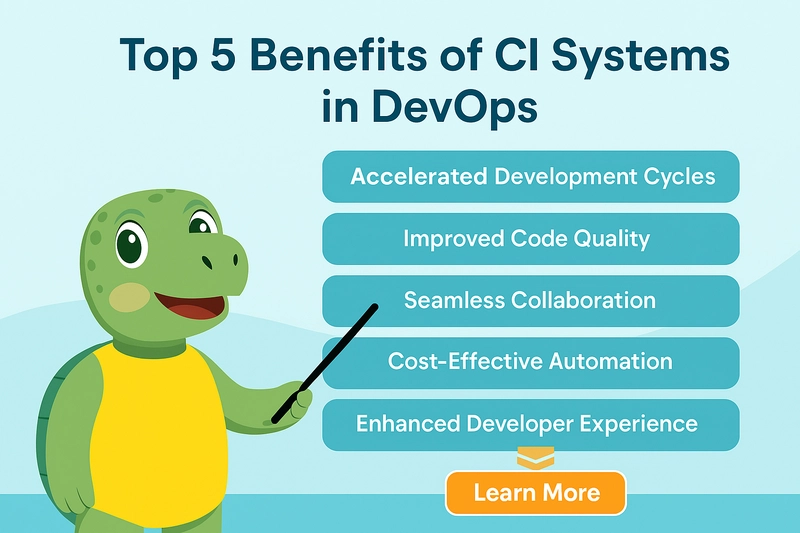Top 5 Benefits of Using a Continuous Integration (CI) System 55542342 title
Top 5 Benefits of Using a Continuous Integration (CI) System In today's fast-paced software development landscape, CI system implementation has become essential for successful DevOps practices. Whether you're managing a small project or leading enterprise-level development, the right CI system can dramatically transform your workflow efficiency and code quality. TurtleCI offers a powerful yet free CI/CD platform that seamlessly integrates with your existing DevOps toolchain. Let's explore the top five benefits that make CI systems indispensable for modern development teams. 5 POWERFUL BENEFITS OF CI SYSTEM 1. Accelerated Development Cycles CI system platforms like TurtleCI automate the integration process, eliminating manual steps that typically slow down development. When developers commit code changes to a shared repository, these changes are automatically built, tested, and validated against predefined criteria. The result? Development cycles that move significantly faster with fewer bottlenecks. Teams using CI system in DevOps report delivery speeds improving by up to 63% compared to traditional development approaches. This acceleration happens through several key mechanisms that modern CI system provides: CI System Automates Build Processes Gone are the days of waiting for manual builds or dealing with "it works on my machine" scenarios. CI system automatically compiles code across multiple environments, ensuring consistency regardless of where the application will ultimately be deployed. TurtleCI's parallel build capability can process multiple components simultaneously, further reducing wait times. Instant Feedback Loops Developers receive immediate notifications about build failures or test issues, allowing them to address problems while the code is still fresh in their minds. This quick feedback significantly reduces the cost of fixing bugs compared to discovering them days or weeks later. TurtleCI's notification system integrates with Slack, MS Teams, and email to keep teams informed in real-time. Parallel Testing Frameworks Modern CI system distributes tests across multiple environments simultaneously. What might take hours sequentially can be completed in minutes with TurtleCI's distributed testing architecture. Teams can run unit tests, integration tests, and even end-to-end tests on every commit without slowing down the development process. Continuous Delivery Preparation By automating the build and test stages, CI system prepares applications for continuous delivery to staging or production environments. TurtleCI's pipeline configurations make it easy to promote code through various environments once all quality gates have been passed. Case Study: CI System Driving Rapid Iteration A mobile development team at FinTech startup QuickPay implemented TurtleCI's CI system and saw their average release cycle decrease from 14 days to just 3 days. Their developers now push smaller, more frequent updates to their repository, confident that TurtleCI will catch any issues before they impact the main branch.

Top 5 Benefits of Using a Continuous Integration (CI) System
In today's fast-paced software development landscape, CI system implementation has become essential for successful DevOps practices. Whether you're managing a small project or leading enterprise-level development, the right CI system can dramatically transform your workflow efficiency and code quality.
TurtleCI offers a powerful yet free CI/CD platform that seamlessly integrates with your existing DevOps toolchain. Let's explore the top five benefits that make CI systems indispensable for modern development teams.
5 POWERFUL BENEFITS OF CI SYSTEM
1. Accelerated Development Cycles
CI system platforms like TurtleCI automate the integration process, eliminating manual steps that typically slow down development. When developers commit code changes to a shared repository, these changes are automatically built, tested, and validated against predefined criteria.
The result? Development cycles that move significantly faster with fewer bottlenecks. Teams using CI system in DevOps report delivery speeds improving by up to 63% compared to traditional development approaches.
This acceleration happens through several key mechanisms that modern CI system provides:
CI System Automates Build Processes
Gone are the days of waiting for manual builds or dealing with "it works on my machine" scenarios. CI system automatically compiles code across multiple environments, ensuring consistency regardless of where the application will ultimately be deployed. TurtleCI's parallel build capability can process multiple components simultaneously, further reducing wait times.
Instant Feedback Loops
Developers receive immediate notifications about build failures or test issues, allowing them to address problems while the code is still fresh in their minds. This quick feedback significantly reduces the cost of fixing bugs compared to discovering them days or weeks later. TurtleCI's notification system integrates with Slack, MS Teams, and email to keep teams informed in real-time.
Parallel Testing Frameworks
Modern CI system distributes tests across multiple environments simultaneously. What might take hours sequentially can be completed in minutes with TurtleCI's distributed testing architecture. Teams can run unit tests, integration tests, and even end-to-end tests on every commit without slowing down the development process.
Continuous Delivery Preparation
By automating the build and test stages, CI system prepares applications for continuous delivery to staging or production environments. TurtleCI's pipeline configurations make it easy to promote code through various environments once all quality gates have been passed.
Case Study: CI System Driving Rapid Iteration
A mobile development team at FinTech startup QuickPay implemented TurtleCI's CI system and saw their average release cycle decrease from 14 days to just 3 days. Their developers now push smaller, more frequent updates to their repository, confident that TurtleCI will catch any issues before they impact the main branch.











































































































































































![[The AI Show Episode 142]: ChatGPT’s New Image Generator, Studio Ghibli Craze and Backlash, Gemini 2.5, OpenAI Academy, 4o Updates, Vibe Marketing & xAI Acquires X](https://www.marketingaiinstitute.com/hubfs/ep%20142%20cover.png)




























































































































![[DEALS] The Premium Learn to Code Certification Bundle (97% off) & Other Deals Up To 98% Off – Offers End Soon!](https://www.javacodegeeks.com/wp-content/uploads/2012/12/jcg-logo.jpg)


![From drop-out to software architect with Jason Lengstorf [Podcast #167]](https://cdn.hashnode.com/res/hashnode/image/upload/v1743796461357/f3d19cd7-e6f5-4d7c-8bfc-eb974bc8da68.png?#)








































































































.png?#)

































_Christophe_Coat_Alamy.jpg?#)
 (1).webp?#)





































































































![Apple Considers Delaying Smart Home Hub Until 2026 [Gurman]](https://www.iclarified.com/images/news/96946/96946/96946-640.jpg)
![iPhone 17 Pro Won't Feature Two-Toned Back [Gurman]](https://www.iclarified.com/images/news/96944/96944/96944-640.jpg)
![Tariffs Threaten Apple's $999 iPhone Price Point in the U.S. [Gurman]](https://www.iclarified.com/images/news/96943/96943/96943-640.jpg)



































































































































